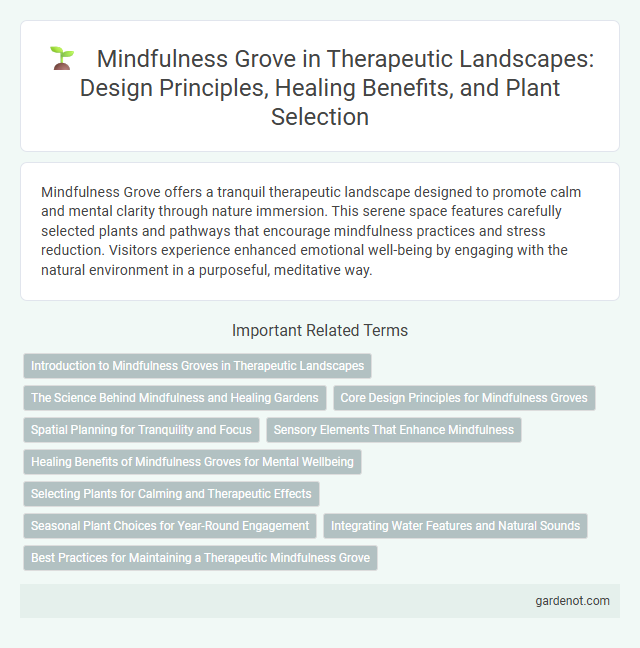Mindfulness Grove offers a tranquil therapeutic landscape designed to promote calm and mental clarity through nature immersion. This serene space features carefully selected plants and pathways that encourage mindfulness practices and stress reduction. Visitors experience enhanced emotional well-being by engaging with the natural environment in a purposeful, meditative way.
Introduction to Mindfulness Groves in Therapeutic Landscapes
Mindfulness groves are specially designed natural environments that promote mental well-being through sensory engagement and meditative practices. These therapeutic landscapes integrate elements such as native plants, quiet pathways, and seating areas to encourage relaxation, reduce stress, and enhance mindfulness. Research highlights their effectiveness in supporting mental health by fostering present-moment awareness and emotional regulation.
The Science Behind Mindfulness and Healing Gardens
Research in therapeutic landscapes demonstrates that mindfulness practices combined with healing gardens significantly reduce stress and enhance emotional well-being. Neuroimaging studies reveal that exposure to natural environments activates brain regions associated with relaxation and attention regulation, supporting mindfulness's cognitive benefits. Healing gardens provide multisensory stimulation that promotes physiological restoration, reinforcing the science behind mindfulness as a powerful tool for mental health improvement.
Core Design Principles for Mindfulness Groves
Mindfulness groves are designed to cultivate tranquility through natural elements such as native plant species, water features, and contemplative seating arrangements. Core design principles emphasize sensory engagement, spatial harmony, and accessibility to facilitate immersive meditation experiences. Careful integration of shade, soundscapes, and natural textures supports sustained mindfulness practice within therapeutic landscape settings.
Spatial Planning for Tranquility and Focus
Mindfulness Grove integrates spatial planning principles to enhance tranquility and focus by designing natural landscapes that reduce sensory overload and promote psychological restoration. Strategic placement of vegetation, water features, and seating areas creates microenvironments conducive to meditation and mindful practices, facilitating deep mental relaxation. These carefully curated spaces support therapeutic outcomes by encouraging sustained attention and reducing stress through immersive, nature-based experiences.
Sensory Elements That Enhance Mindfulness
The Mindfulness Grove incorporates diverse sensory elements such as aromatic herbs, textured pathways, and gentle water features to heighten awareness and presence. These natural stimuli engage smell, touch, and hearing, fostering a deeper connection to the environment and promoting mental clarity. Integrating these sensory components supports stress reduction and enhances overall mindfulness practice within the therapeutic landscape.
Healing Benefits of Mindfulness Groves for Mental Wellbeing
Mindfulness groves serve as tranquil natural settings that significantly enhance mental wellbeing by reducing stress and promoting emotional balance through guided meditation and sensory immersion. Research indicates exposure to these serene environments lowers cortisol levels and enhances neural connectivity in brain regions associated with attention and self-regulation. The integration of mindfulness practices within these groves supports recovery from anxiety and depression by fostering present-moment awareness and resilience.
Selecting Plants for Calming and Therapeutic Effects
Mindfulness groves incorporate plants like lavender, chamomile, and jasmine for their calming and therapeutic properties, promoting stress reduction and mental clarity. These species release natural aromas and essential oils known to enhance relaxation and emotional well-being. Carefully selecting native and low-allergen plants ensures a safe, soothing environment that supports mindfulness practices and holistic healing.
Seasonal Plant Choices for Year-Round Engagement
Mindfulness groves incorporate diverse seasonal plant choices to ensure year-round engagement and therapeutic benefits. Deciduous trees such as maples provide vibrant fall colors, while evergreens like pines maintain greenery during winter months, promoting continuous visual interest and a calming atmosphere. Perennials and native wildflowers bloom in spring and summer, enhancing sensory experiences and supporting mental health through nature connection.
Integrating Water Features and Natural Sounds
Mindfulness groves enhance therapeutic landscapes by integrating water features such as gentle streams and cascading fountains that promote relaxation and stress reduction. Natural sounds from flowing water combined with bird calls foster a calming environment, supporting mental well-being and mindfulness practices. These sensory elements strengthen the connection to nature, encouraging presence and emotional balance within healing gardens.
Best Practices for Maintaining a Therapeutic Mindfulness Grove
Maintaining a therapeutic mindfulness grove requires ensuring diverse native plant species to promote biodiversity and a calming atmosphere. Regularly scheduled mindfulness sessions and quiet reflection zones enhance mental well-being and stress reduction. Consistent upkeep, such as pruning, mulching, and waste removal, preserves the grove's aesthetic and supports its therapeutic functions.
Mindfulness grove Infographic

 gardenot.com
gardenot.com